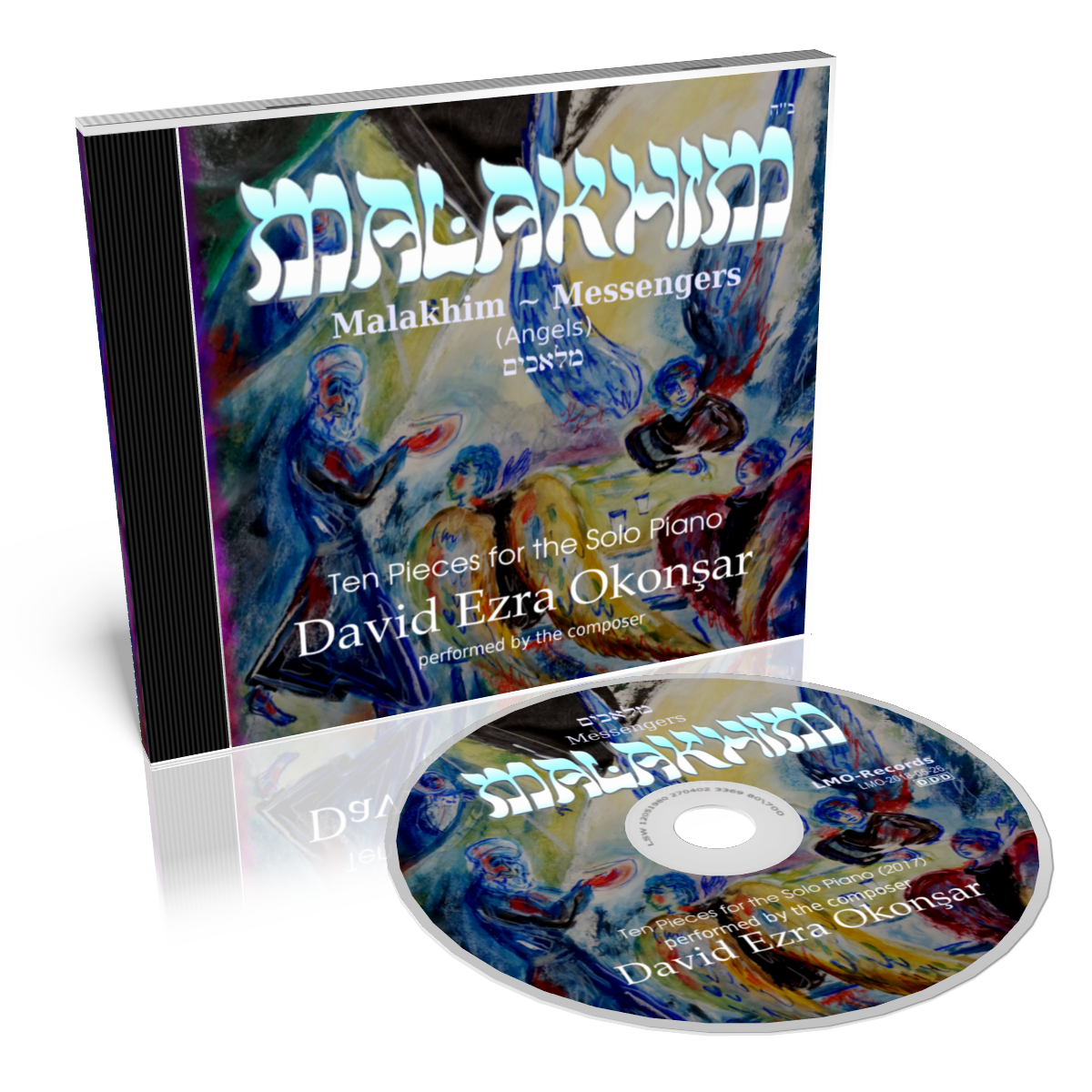
(Angels)
Ten Pieces For The Solo Piano
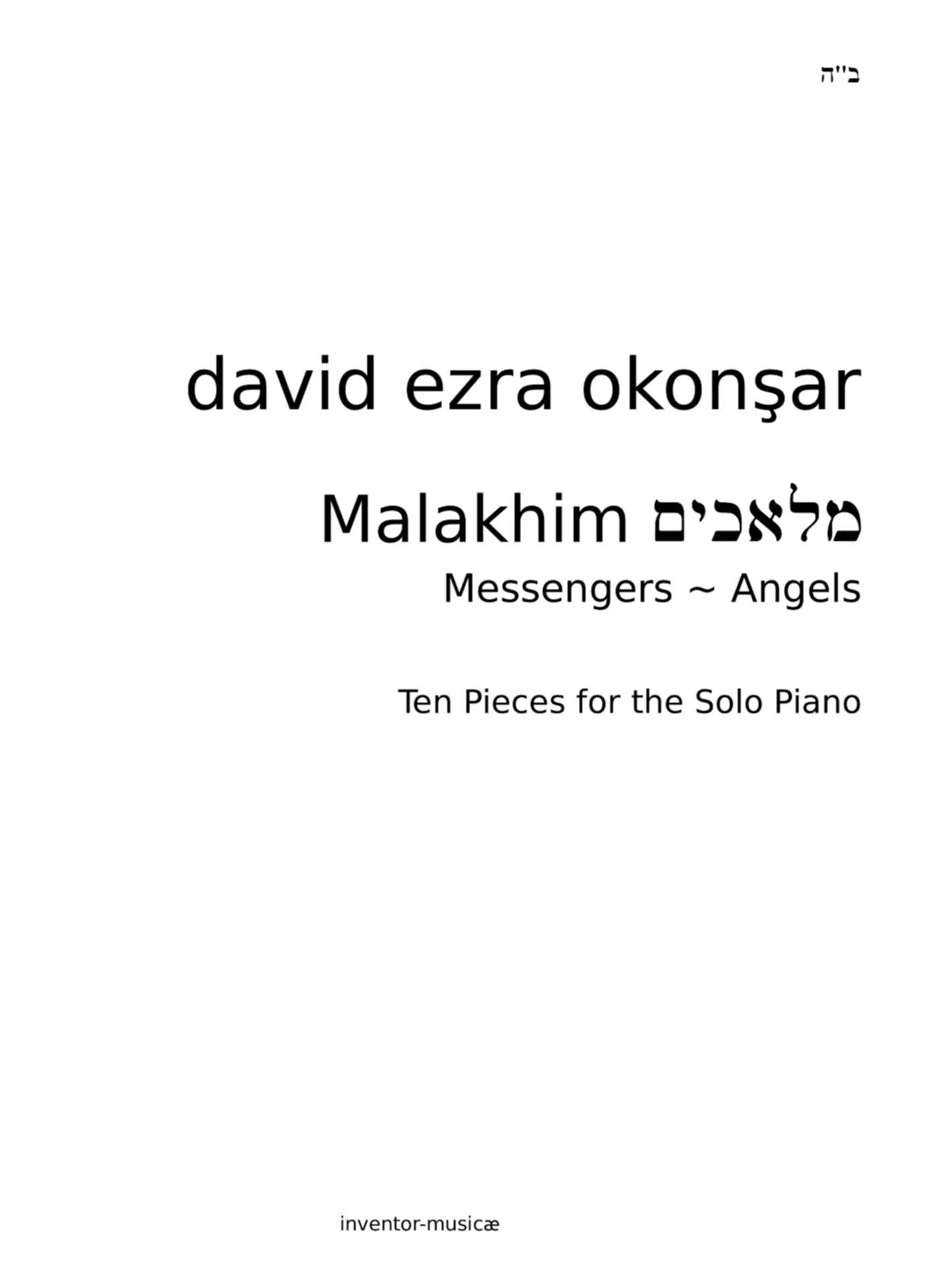
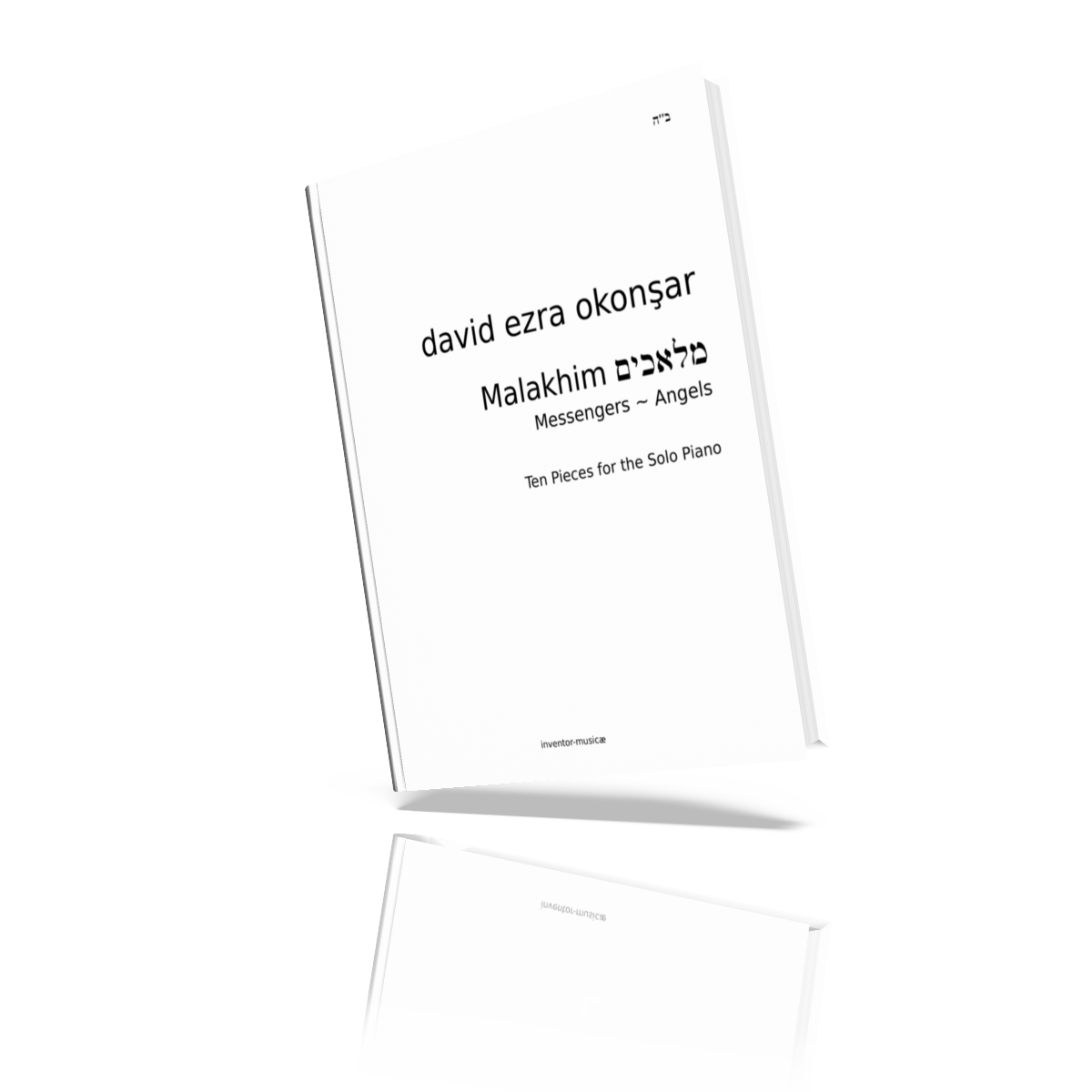
|
Malakhim (מלאכים, melakhim, malachim), often translated as "angels", literally means messengers. This aspect of the concept constitutes the basic idea for the composition. An angel is a spiritual being and does not have any physical characteristics. The angelic descriptions provided by the prophets - such as wings, arms etc. - are anthropomorphic, referring to their spiritual abilities and tasks. We read first about angels calling out to Abraham, then, angels appearing in Jacob's dream, Jacob fighting with an angel, and angels are then mentioned numerous times throughout the Tanakh. Some angels are created for one specific task, and upon the task's completion cease to exist. According to the Zohar one of the angels' tasks is to transport our words of prayer and Torah-study before G‑d's throne. Another type of angels are those that are created through the deeds of man. These are formed from the intellectual and emotional energy which one invests in the performance of a mitzvah, the study of Torah, or in prayer. [wkp] Those entities are actually devoid of free will and they are "programmed" for one task only. Such as Michael, who is dispatched on missions, which are expressions of G‑d's kindness; Gavriel, who executes G‑d's severe judgments; and Rafael, whose responsibility it is to heal. [chbd] The Malakhim, messengers or angels may be said to be typically "mono-thematic" beings. Therefore, the entire cycle is constructed each piece with one single idea, they are, in a sense "mono-thematic". To musically reflect the idea of an angel as a "limited" and "closed-system" being, each derived from a single source (G.d's power), but somehow independent from it, I made a master tone-series but did not use it as is as the main series of any piece which makes the cycle.  Ten derivative series were formed from this main one, one for each particular piece. However, in some pieces, from time to time, the main tone-row appears in its original form. This master series is mainly featuring minor and major thirds, but the perfect four interval which is so characteristic in the symbolism of the Western music as a reference to the "divine harmony", since and even before J. S. Bach to our days, is also noticeably present. Three typical, "leitmotiv" chords, each made of four successive pitches of the main series, do appear in each piece, in various forms. Those chords are: I: [C-E flat-A flat- B] II: [D-F sharp-G-B flat] III: [C sharp-E-F-A].  Two groups of six notes in quick succession is another "leitmotiv", often exposed throughout the pieces: I: [C-E flat- A flat-B-F sharp-D] II: [G-b flat-F-C sharp-E-A].  The continuity of the series of pieces is based on the analogies of each particular tone-row with the main one. The titles and order of the pieces are based on the commonly accepted names and hierarchical order of angels, as established by Moshe bin Maimon (Maimonides a.k.a Rambam, 1135-1204) in his Mishneh Torah. Rabbi Moses ben Maimon, a Jewish philosopher, was one of the most prolific and influential Torah scholars of the Middle Ages. The Mishneh Torah, probably his most important work, is a code of Jewish religious law (Halakha) and it was compiled while Maimonides was living in Egypt, between 1170 and 1180. [wkp] Maimonides counts ten ranks of angels in the Jewish angelic hierarchy, beginning from the highest: Chayot Ha Kodesh; Ophanim; Erelim; Hashmallim; Seraphim; Malakim; Elohim; Bene Elohim; Cherubim; Ishim. This order is respected, but in reverse order, from the lowest to the highest in the cycle. The ten pieces for the piano, inspired by the denominations, hierarchical order (reversed) and commonly given attributes of beings referred to as "angels" (Malakhim, messengers) as described by Maimonides are: I - Ishim: "manlike" beings [Genesis 10-5 and Daniel 10-5] II - Cherubim: "unearthly beings who directly attend to God" [Ezekiel 10-1] III - Bene Elohim: "Sons of Godly beings" [Genesis 6:1-4 and Job: 1:6, Job: 38:7] IV - Elohim: "Godly beings" [Bereshit 1:1] V - Malakim: messengers, angels VI - Seraphim: "the burning one" [Isaiah 6] VII - Hashmallim: "stormy wind coming from the north" [Ezekiel 1:4] VIII - Erelim: "the valiant, courageous" [Isaiah 33:7] IX - Ophanim: "the wheels that never sleep" [Ezekiel 1 and Ezekiel 10] X - Chayot Ha Kodesh: "living beings, angels of fire" [Ezekiel 1 and Ezekiel 10] I - ISHIM ("manlike beings") In Judaism, the Ishim (אִישִׁים - "men", "personages", "personalities", "individuals") or Eshim (אֵשִׁים - "fires", "flames", "sparks") are a class of angels said to be the closest to humanity's affairs. They are composed of fire and snow, and are described as "the beautiful souls of just men" who reside in Makon, the fifth Heaven. [wkp] Genesis Chapter 10-5 בְּרֵאשִׁית and he lifted up his eyes
and looked, and, lo, three men stood over against him; and when he saw
them, he ran to meet them from the tent door, and bowed down to the
earth, [mm]
ב וַיִּשָּׂא עֵינָיו,
וַיַּרְא, וְהִנֵּה שְׁלֹשָׁה אֲנָשִׁים, נִצָּבִים עָלָיו; וַיַּרְא,
וַיָּרָץ לִקְרָאתָם מִפֶּתַח הָאֹהֶל, וַיִּשְׁתַּחוּ, אָרְצָה
Daniel Chapter 10-5 דָּנִיֵּאל I lifted up mine eyes, and looked, and behold a man clothed in linen, whose loins were girded with fine gold of Uphaz;
ה וָאֶשָּׂא אֶת-עֵינַי וָאֵרֶא, וְהִנֵּה אִישׁ-אֶחָד לָבוּשׁ בַּדִּים; וּמָתְנָיו חֲגֻרִים, בְּכֶתֶם אוּפָז.
Ishim is a very strong piece with bursts of dazzling light. Short phrases with incisive rhythms alternate with softer sections with, again short phrases.  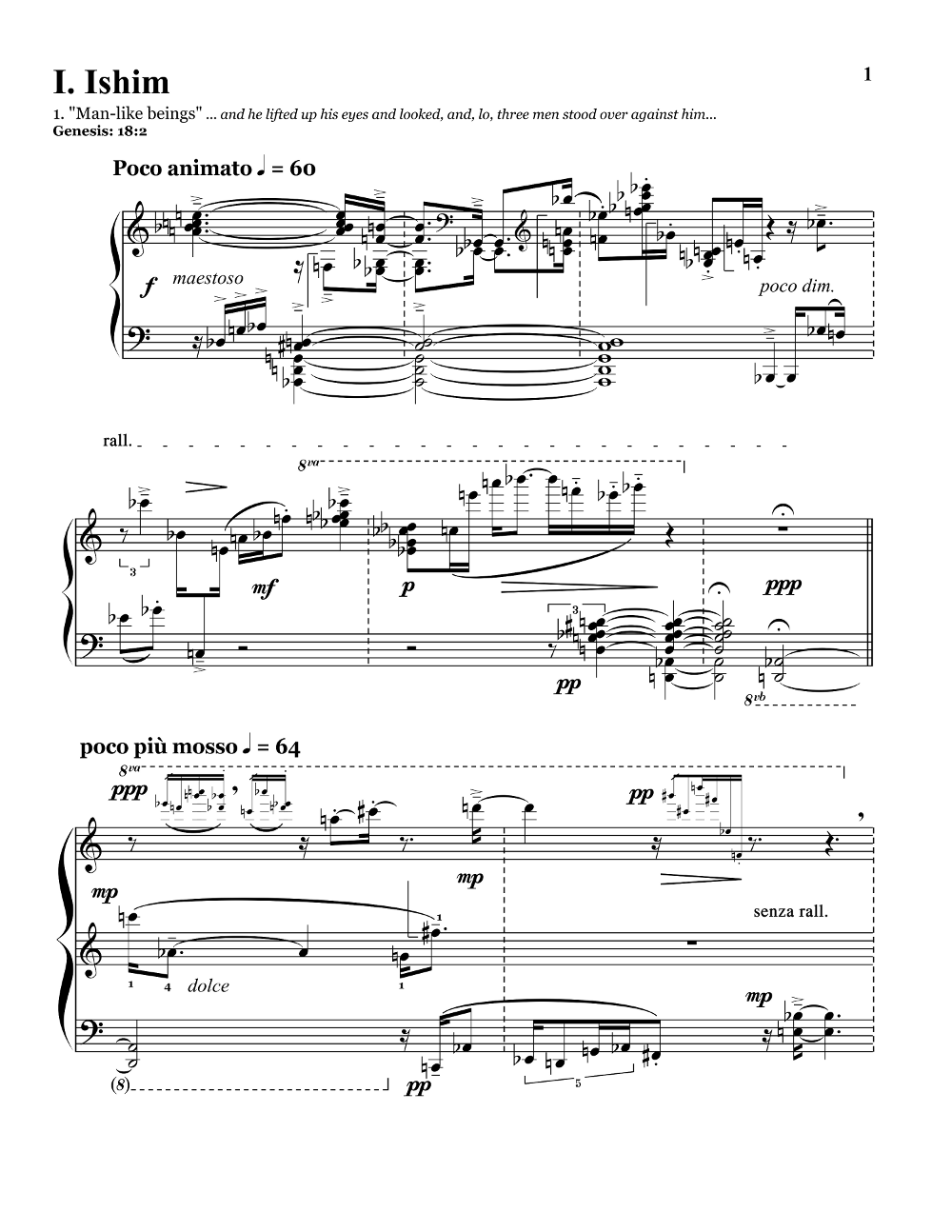 II - CHERUBIM ("unearthly beings who directly attend to God") A cherub (כְּרוּב) is one of the unearthly beings who directly attend to God. The numerous depictions of cherubim assign to them many different roles; their original duty having been the protection of the Garden of Eden. Angelic status is not attributed to cherubim in the Torah (at least not explicitly); only in later sources such as De Coelesti Hierarchia [1] are they identified as a hierarchical rank of angels. Different sources give conflicting information as to the physical appearance of cherubim. An early, traditional Jewish notion supposes that cherubim had youthful, human features, although some early midrashic literature [2] conceives of the cherubim as non-corporeal. In the Book of Ezekiel and some Christian icons, the cherub is depicted as having a number of wing pairs, and four faces. A lion (representative of all wild animals), an ox (domestic animals), a human (humanity), and an eagle (birds). [wkp] Ezekiel Chapter 10-1 יְחֶזְקֵאל Then I looked, and,
behold, upon the firmament that was over the head of the cherubim,
there appeared above them as it were a sapphire stone, as the
appearance of the likeness of a throne.
א וָאֶרְאֶה, וְהִנֵּה
אֶל-הָרָקִיעַ אֲשֶׁר עַל-רֹאשׁ הַכְּרֻבִים, כְּאֶבֶן סַפִּיר,
כְּמַרְאֵה דְּמוּת כִּסֵּא--נִרְאָה, עֲלֵיהֶם.
10-2 And He spoke unto the
man clothed in linen, and said: 'Go in between the wheelwork, even
under the cherub, and fill both thy hands with coals of fire from
between the cherubim, and dash them against the city.' And he went in
my sight.
ב וַיֹּאמֶר אֶל-הָאִישׁ
לְבֻשׁ הַבַּדִּים, וַיֹּאמֶר בֹּא אֶל-בֵּינוֹת לַגַּלְגַּל אֶל-תַּחַת
לַכְּרוּב וּמַלֵּא חָפְנֶיךָ גַחֲלֵי-אֵשׁ מִבֵּינוֹת לַכְּרֻבִים,
וּזְרֹק, עַל-הָעִיר; וַיָּבֹא, לְעֵינָי
10-3 Now the cherubim stood on the right side of the house, when the man went in; and the cloud filled the inner court.
ג וְהַכְּרֻבִים, עֹמְדִים מִימִין לַבַּיִת--בְּבֹאוֹ הָאִישׁ; וְהֶעָנָן מָלֵא, אֶת-הֶחָצֵר הַפְּנִימִית.
10-4 And the glory of the
LORD mounted up from the cherub to the threshold of the house; and the
house was filled with the cloud, and the court was full of the
brightness of the LORD'S glory.
ד וַיָּרָם כְּבוֹד-יְהוָה
מֵעַל הַכְּרוּב, עַל מִפְתַּן הַבָּיִת; וַיִּמָּלֵא הַבַּיִת,
אֶת-הֶעָנָן, וְהֶחָצֵר מָלְאָה, אֶת-נֹגַהּ כְּבוֹד יְהוָה.
10-5 And the sound of the
wings of the cherubim was heard even to the outer court, as the voice
of God Almighty when He speaketh.
ה וְקוֹל, כַּנְפֵי הַכְּרוּבִים--נִשְׁמַע, עַד-הֶחָצֵר הַחִיצֹנָה: כְּקוֹל אֵל-שַׁדַּי, בְּדַבְּרוֹ.
A scherzo-like piece, Cherubim is mostly made of fast and unpredicted rhythms. It is jumping swiftly across the keyboard.   III - BENE ELOHIM ("Sons of Godly beings") "Sons of God" (בני האלהים) is a phrase used in the Torah. The phrase is also used in Kabala where Bene Elohim are part of different Jewish angelic hierarchies. The first mention of "sons of God" in the Torah occurs at Genesis 6:1-4. In Judaism "Sons of God" usually refers to the righteous, i.e. the children of Seth and all of the earliest sources interpret the "sons of God" as angels. Genesis 6:1-4 בְּרֵאשִׁית The Nephilim were in the
earth in those days, and also after that, when the sons of God came in
unto the daughters of men, and they bore children to them; the same
were the mighty men that were of old, the men of renown.
ד הַנְּפִלִים הָיוּ
בָאָרֶץ, בַּיָּמִים הָהֵם, וְגַם אַחֲרֵי-כֵן אֲשֶׁר יָבֹאוּ בְּנֵי
הָאֱלֹהִים אֶל-בְּנוֹת הָאָדָם, וְיָלְדוּ לָהֶם: הֵמָּה הַגִּבֹּרִים
אֲשֶׁר מֵעוֹלָם, אַנְשֵׁי הַשֵּׁם.
Three more occurrences are found in the Book of Job: 1:6; 2:1; 38:7 Job: 1:6 אִיּוֹב Now it fell upon a day, that the sons of God came to present themselves before the LORD, and Satan came also among them.
ו וַיְהִי הַיּוֹם--וַיָּבֹאוּ בְּנֵי הָאֱלֹהִים, לְהִתְיַצֵּב עַל-יְהוָה; וַיָּבוֹא גַם-הַשָּׂטָן, בְּתוֹכָם.
Job: 38:7 When the morning stars sang together, and all the sons of God shouted for joy?
ז בְּרָן-יַחַד, כּוֹכְבֵי בֹקֶר; וַיָּרִיעוּ, כָּל-בְּנֵי אֱלֹהִים.
 Bene Elohim s a tender piece, mixing some scherzo-like elements with long-breathed and cuddly melodic lines. 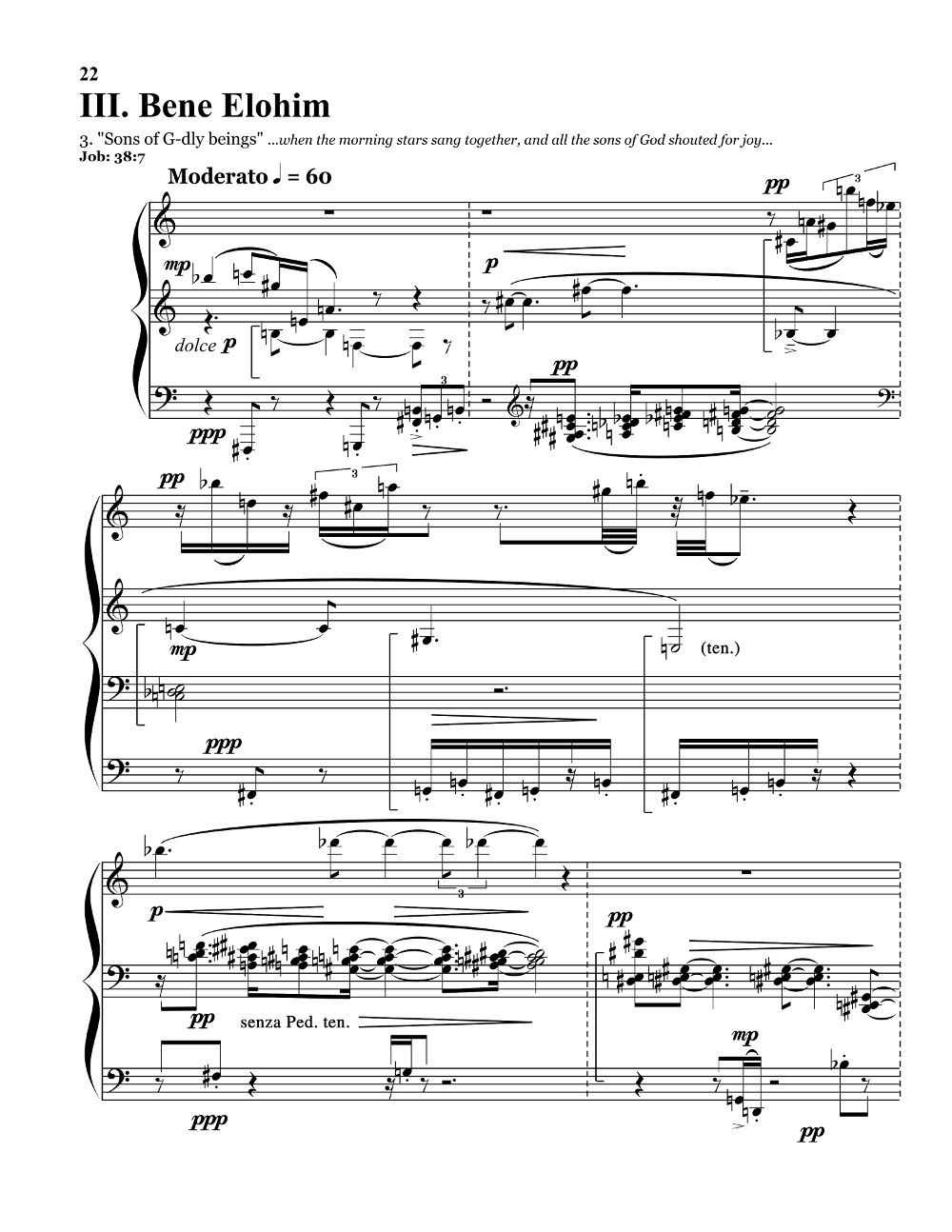 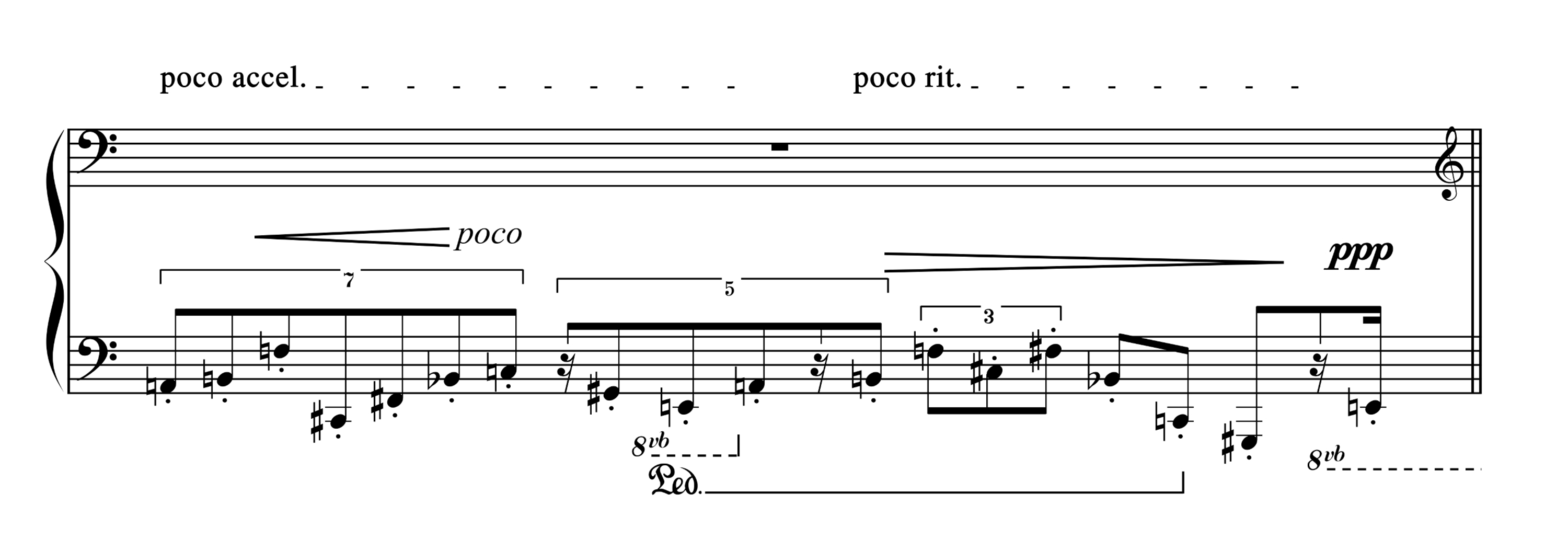 Worth noting in this piece also the use of the B-Major and F-sharp minor "chords" that I call "entities" for they are being used without reference to the tonal grammar, but as persisting, typical, sound-colors. 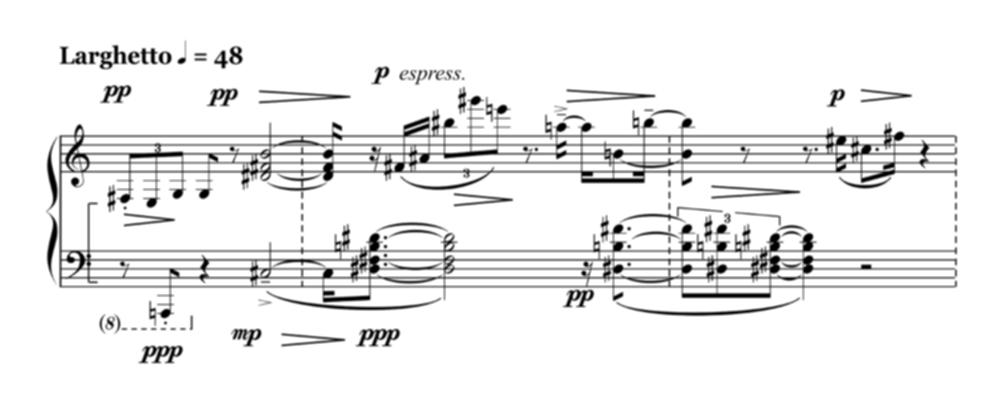 IV - ELOHIM ("Godly beings") Elohim (אֱלֹהִים) is a grammatically plural noun for "gods" or "deity" in Biblical Hebrew. In Modern Hebrew, it is often referred to in the singular despite the -im ending that denotes plural masculine nouns in Hebrew. [wkp] The first Name used for God in scripture is Elohim. This Name is used in scripture when emphasizing God's might, His creative power, and his attributes of justice and rulership. Variations on this name include El, Eloah, Elohai (my God), and Eloheynu (our God). [wkp] Elohim occupies the seventh rank of ten in the famous medieval Rabbinic scholar Maimonides' Jewish angelic hierarchy. [wkp] Bereshit: 1 In the beginning God created the heaven and the earth.
א בְּרֵאשִׁית, בָּרָא אֱלֹהִים, אֵת הַשָּׁמַיִם, וְאֵת הָאָרֶץ.
 This fourth piece of the series represents the limitless power. Complex lines each loaded with great energy mingle with each other. 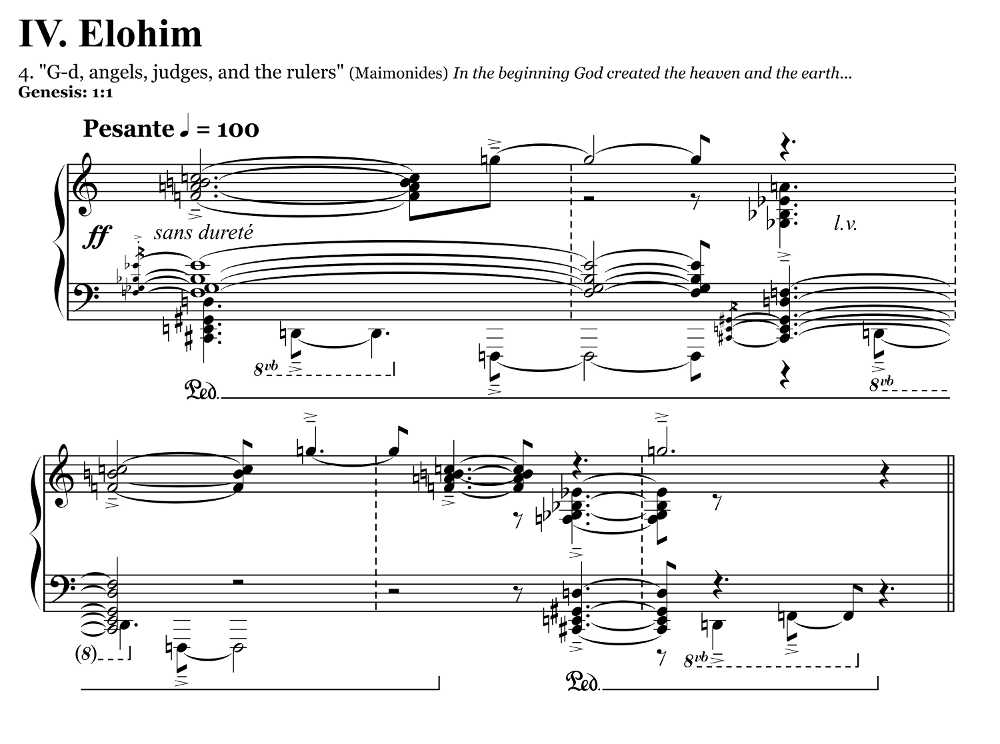 Soft sections are more hunched up with more "square" rhythms  Another "persistent entity" is present here as the notes A-sharp and B which somewhat refer to the persisting sounds of the preceding piece. This piece also feature one of the rare moments where the basic tone-row is displayed without any inference and in a persistent rhythm. 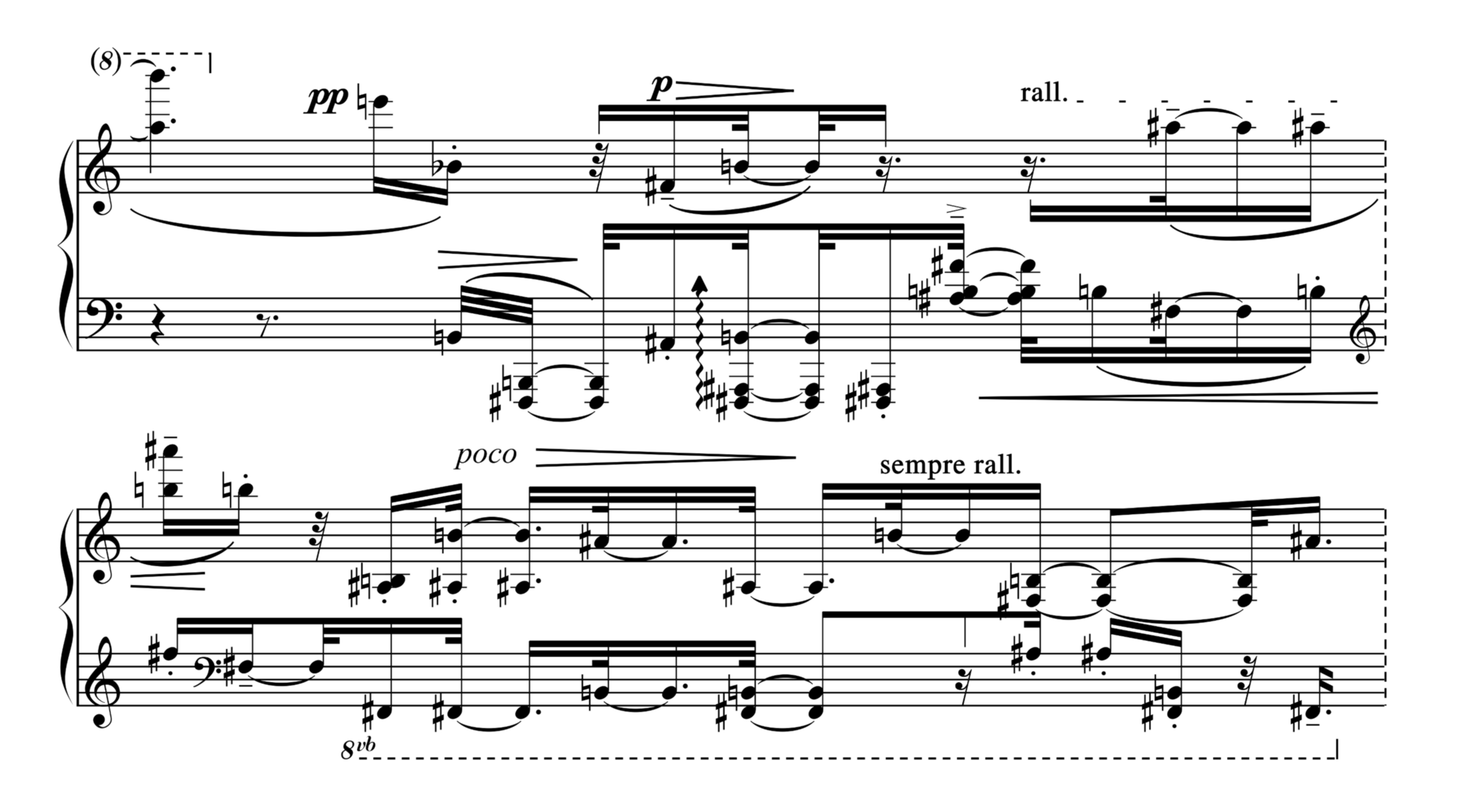 The harsh and dry staccato and fortissimo chords section will constitute the basic element which will go to the end. The staccato element will be combined first with legato lines and then remain alone but pianissimo towards the Coda. 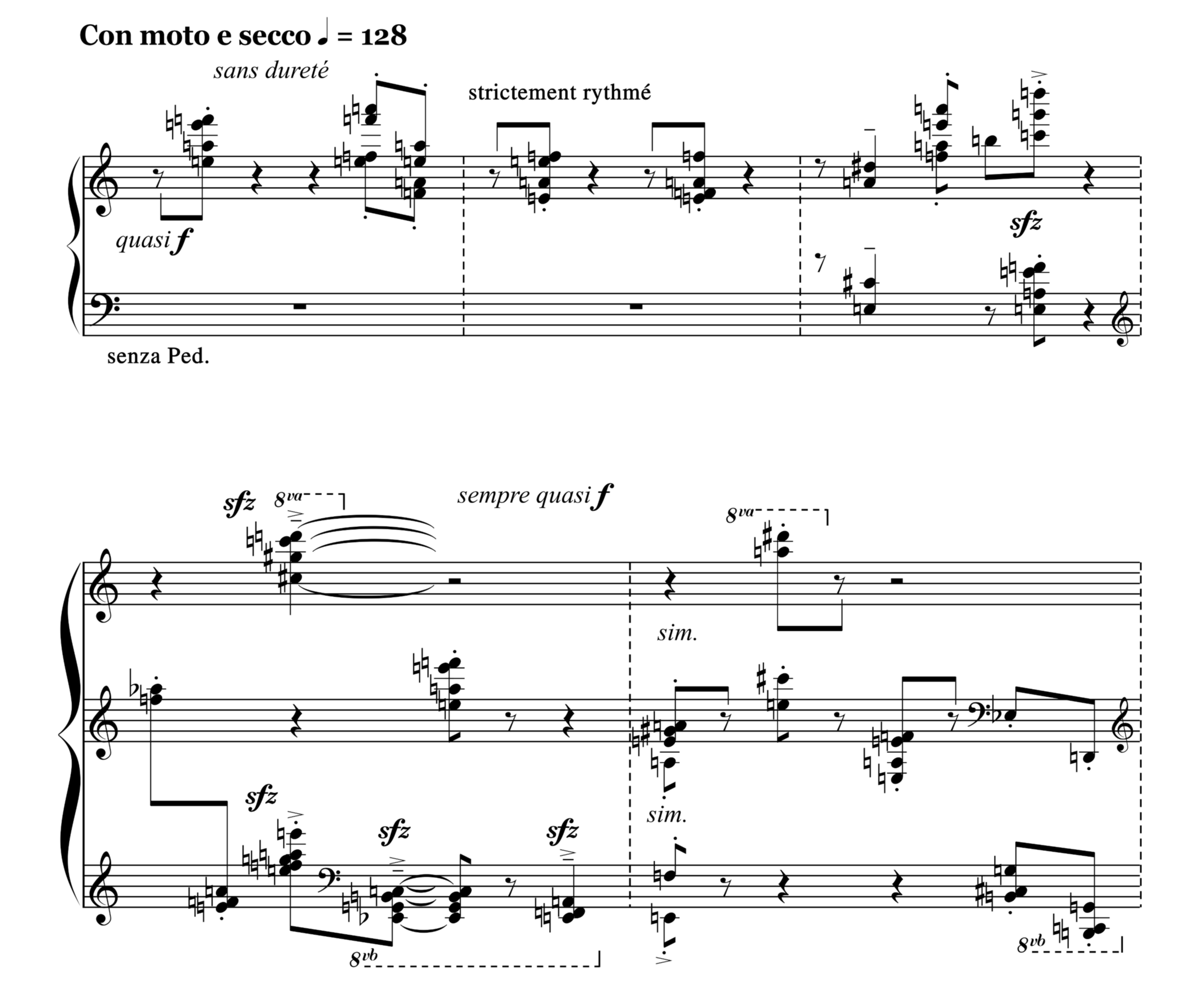 V - MALAKIM ("messengers, angels") In many passages from the Torah, angels are utilized as messengers; indeed, there is no specific Hebrew equivalent for the English word "angel", relying instead on the Hebrew word for "messenger." Angels seem to have the appearance of ordinary humans; they are typically men and (unlike Seraphim), have no wings. [wkp] Regardless, messenger angels are a highly important part of preserving and strengthening the link, as well as necessary distance, of God to humans. The nature of the knowledge that angelic messengers carry is always heavenly; that is to say, it is divine, and only by being sanctioned by God can it be transmitted to humans, and only for necessary reasons. When an angel transmits knowledge from God, his own identity is effaced by that of his Lord; that is, he speaks directly for God. [wkp] Examples of this role can be seen in numerous famous passages from the Torah, including the three mysterious men in the story of Abraham and the destruction of Sodom in Genesis 18:1-19:23, as well as the angel who informs Samson's mother of the nature of the baby she carries in Judges 13:3-5. In these examples, the angels are disguised, their identities unimportant in relation to the heavenly magnitude of the knowledge they possess; they are entirely defined by their jobs. [wkp] Malakhim has something from each previous piece.  It has the bright and strong side of Ishim, the exuberance of Cherubim, the lyricism of Bene Elohim and the power of Elohim combined in various ways. Again in this number the original tone-row appears with a unified pace of quarter notes, however it is combined in counterpoint with a melodic line. 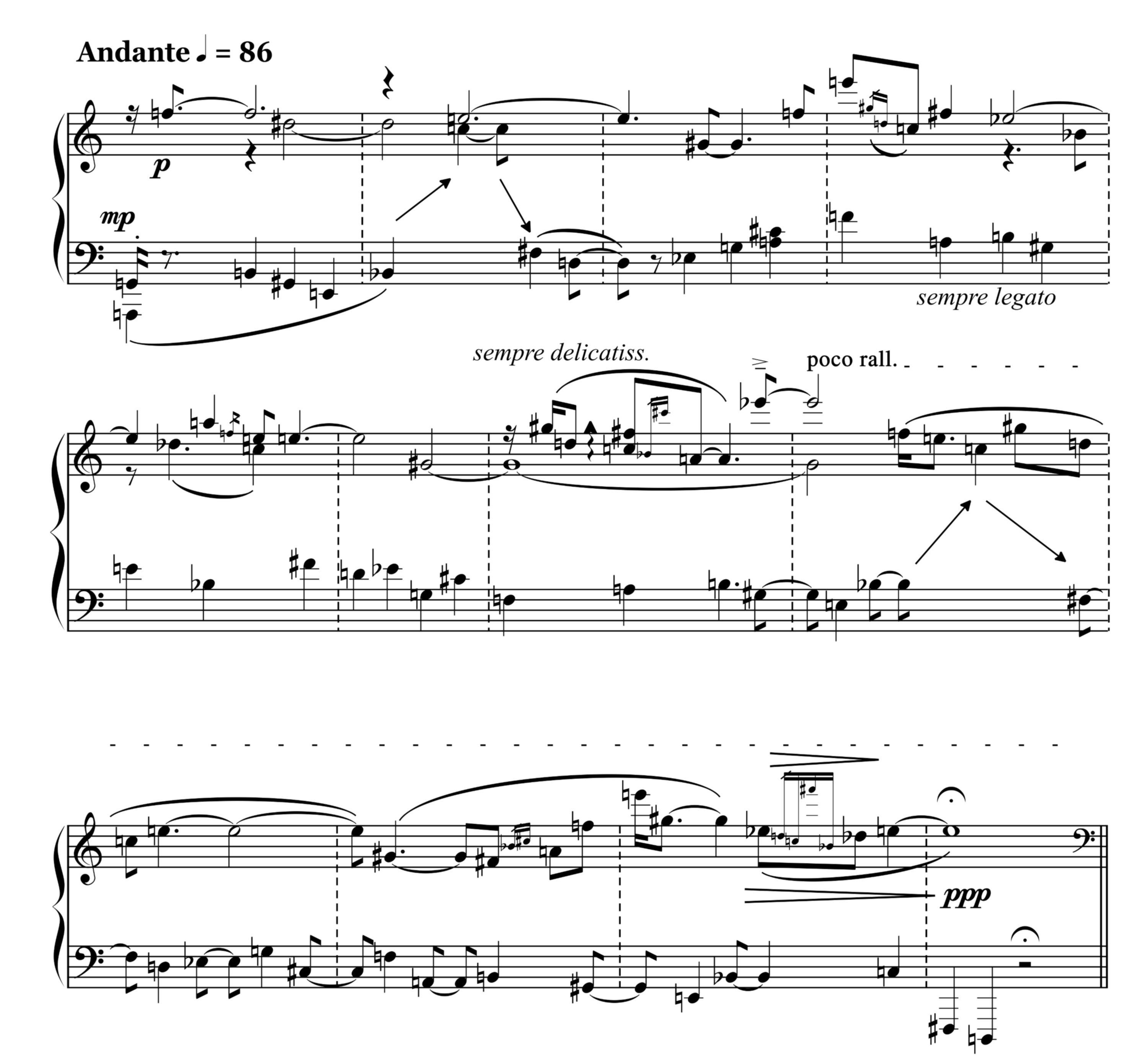 VI - SERAPHIM ("the burning one") Tradition places Seraphim in the highest rank in the Christian angelic hierarchy and in the fifth rank of ten in the Jewish angelic hierarchy. A seminal passage in the Book of Isaiah (Isaiah 6:1-8) used the term to describe six-winged beings that fly around the Throne of God crying "holy, holy, holy". This throne scene, with its triple invocation of holiness, profoundly influenced subsequent theology, literature and art. Its influence is frequently seen in works depicting angels, heaven and apotheosis. Seraphim are mentioned as celestial beings in an influential Hellenistic work, the Book of Enoch, and the Book of Revelation. [wkp] Isaiah 6:1-8 New Revised Standard Version (NRSV) [A Vision of God in the Temple] 1. In the year that
King Uzziah died, I saw the Lord sitting on a throne, high and lofty;
and the hem of his robe filled the temple.
2. Seraphs were in attendance above him; each had six wings: with two they covered their faces, and with two they covered their feet, and with two they flew. 3. And one called to another and said: "Holy, holy, holy is the Lord of hosts; the whole earth is full of his glory."  Meandering, serpentine lines start Seraphim. These lines occur in soft and sinuous passages as well as in sections with strong chords and accents. 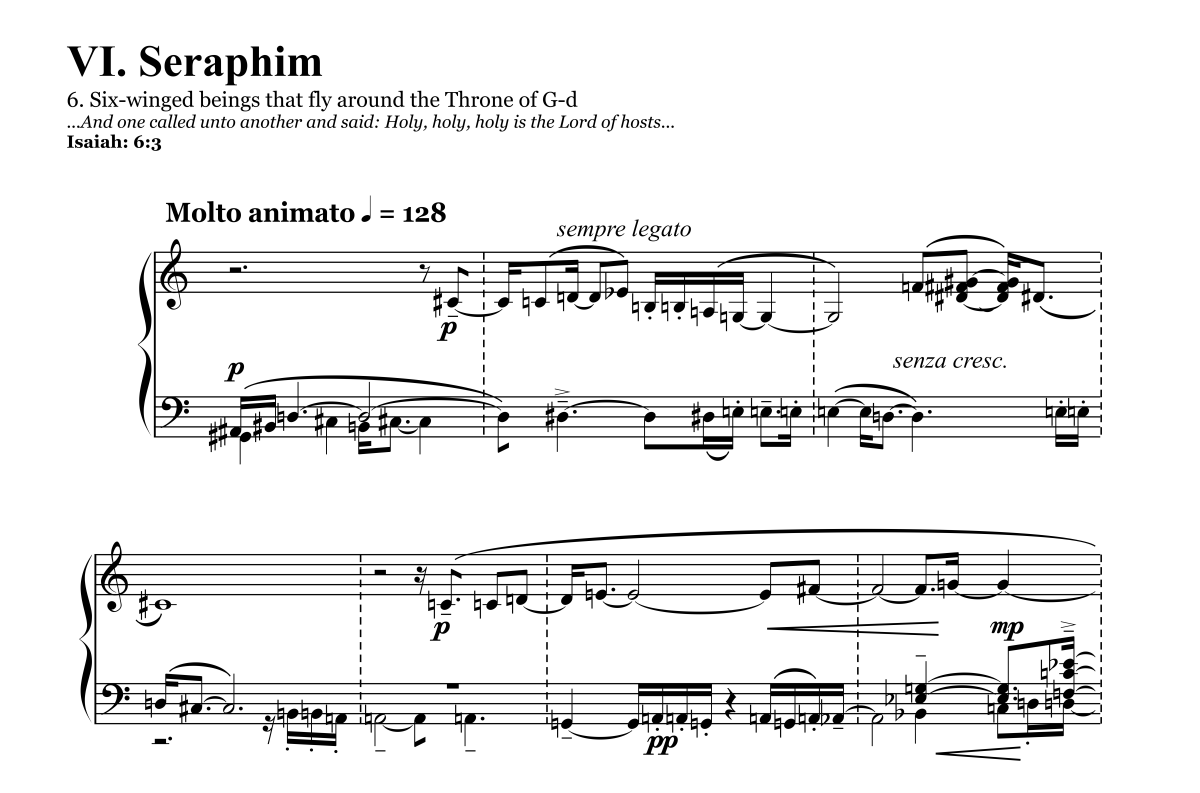 Conundrum is all over the piece, worth noting is the high pitched staccato, pianissimo notes which will start around the middle and bring the puzzling end. {score} VII - HASHMALLIM ("stormy wind coming from the north") Hashmallim occupy the fourth rank of ten in Maimonides's exposition of the Jewish angelic hierarchy. Hashmallim also appear in the Christian angelic hierarchy. The Septuagint translates "hashmal" to "elektron" (ηλεκτρον), which means "amber" in English. Francis Bacon coined the English word "electricity" to describe the static electric effect of rubbing amber with cloth. Later, "hashmal" became the modern Hebrew word that translates to the English word "electricity." [wkp] Gleaming amber, Hashmallim starts with a dense melodic section. Brief and light beams appear time to time. Interwoven lines evolve with grace and fluidity.   Several elements common to the entire cycle of the piece appear either as fast and light runs or steady, moderately paced parts. VIII - ERELIM ("the valiant, courageous") An Arel, Ar'el, or Er'el, more commonly referred to in the plural as "the Erelim", are a rank of angels in Jewish Kabbala and Christian religion. The name is seen to mean "the valiant/courageous". They are generally seen as the third highest rank of divine beings - angels below God. The Erelim angelhood is also believed to be the agents of earthly justice. [wkp] The most challenging, both to the listener and the performer, piece of the series, Erelim takes the idea of the steady, moderate speed unfolding of the tone-rows previously heard towards the end of Hashmallim and takes this to its apex. Mostly notated with sixteenth notes, the tempo and playing characteristics change markedly throughout the piece. Lines of sixteenth notes usually spread over a very large keyboard span. After first materializing as an accompaniment to the "leitmotiv" chords (see above) of the cycle, these lines exhibit a tendency to flounder on the notes E and E-flat.  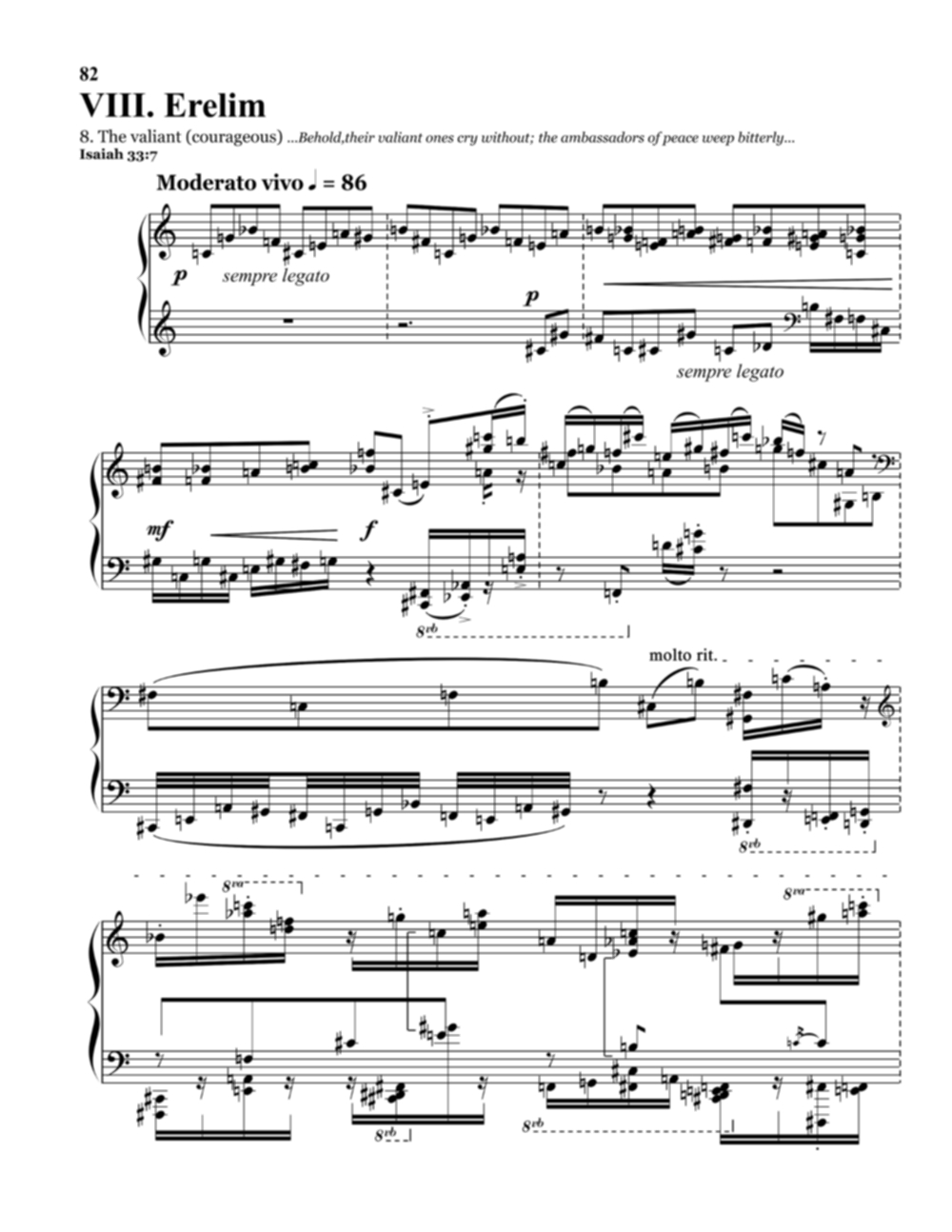 The central part of the piece displays an alternation of two styles: Molto animato (Tempo I) with equal and "secco" no pedal playing and Meno mosso (Tempo II) with "con licenzia" (with liberties with regard to the rhythm) and with pedal. The uninterrupted pace of sixteenth notes ("moto perpetuum") breaks with short rests in several sections, specially in sections with a slower tempo. The short coda features disjointed notes and chords, pianissimo. IX - OPHANIM ("the wheels that never sleep") The Ophanim or Ofanim ("wheels" אוֹפַנִּים), also called galgalim (galgallim, גַּלְגַּלִּים - "spheres", "wheels", "whirlwinds"), refer to the wheels seen in Ezekiel's vision of the chariot ("merkabah") in Ezekiel 1:15-21.[wkp] One of the Dead Sea scrolls (4Q405) construes them as angels; late sections of the Book of Enoch (61:10, 71:7) portray them as a class of celestial beings who (along with the Cherubim and Seraphim) never sleep, but guard the throne of God. Maimonides lists Ophanim as occupying the second of ten ranks of angels in his exposition of the Jewish angelic hierarchy. [wkp] "The wheels that never sleep" is symbolized with full-bodied melodic lines in piece number nine: Ophanim.  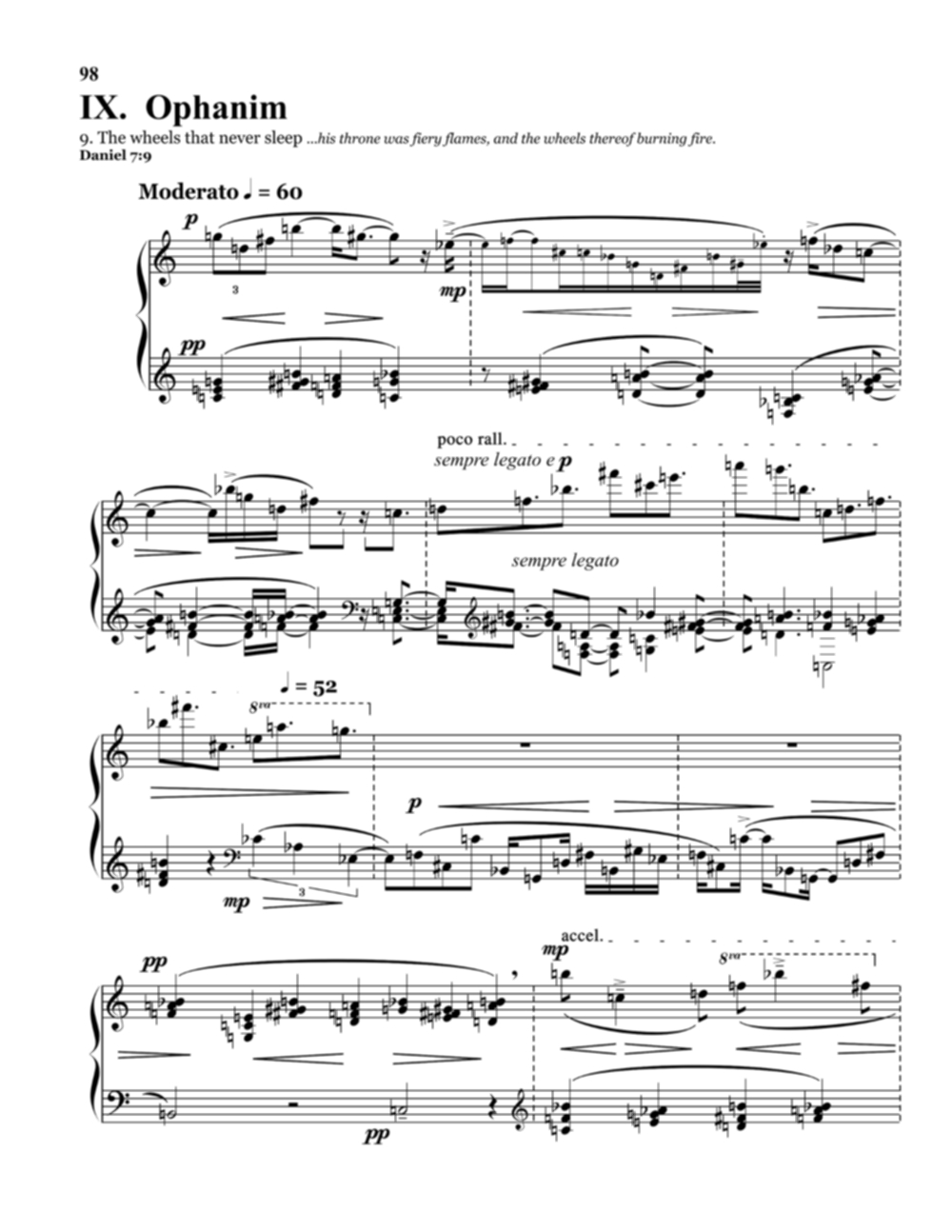 "Mono-rhythmic" passages (sections in one single rhythmic step) abound in this piece. This type of figure, previously heard in Malakhim, Seraphim, Hashmallim and mostly in Erelim, is displayed here very soft and tenderly.  Briefly interrupted with delicate appearances of the linear leitmotivs they start again as small bells ringing in the high ranges. X - CHAYOT HA KODESH ("living beings, angels of fire") The living creatures, living beings, or Hayyoth (חַיּוֹת) are a class of heavenly beings described in Ezekiel's vision of the heavenly chariot in the first and tenth chapters of the Book of Ezekiel. References to the creatures recur in texts of Second Temple Judaism, in rabbinical merkabah ("chariot") literature, and in the Book of Daniel, and also in the Book of Revelation. The "living beings" are considered angels of fire, who hold up the throne of God and the earth itself. They are ranked first in Maimonides' Jewish angelic hierarchy. [wkp] The beginning of that last piece of the cycle, Chayot Ha Kodesh, may seem similar to the introduction of Hashmallim. However, for the first time in the series, no tone-row but instead a full chromatic scale is used.  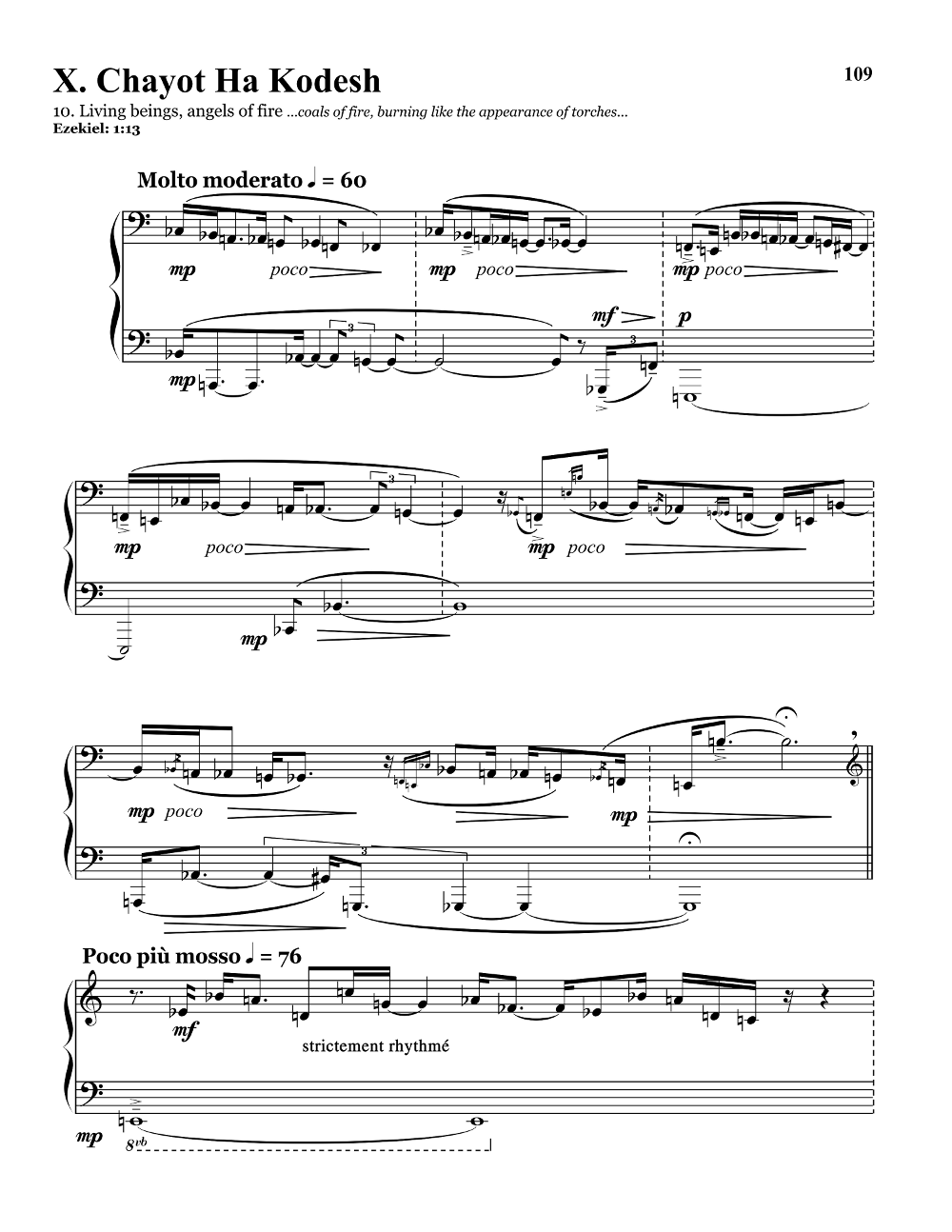 Mono-rhythm tone row displays are again employed here but in wider pitch ranges. The entire central part and the climax of this piece uses a relentless pace of eight notes. The tempo varies somewhat and those mono-rhythm lines are sometimes interrupted with fast notes leitmotives The composition is dedicated to the memory of Alexis Weissenberg (1929-2012).
Cover art by Shoshannah Brumbacher
[chbd]: chabad.org, by Baruch S. Davidson [wkp]: en.wikipedia.org [mm]: all translations from https://www.mechon-mamre.org [1]: De Coelesti Hierarchia is a Pseudo-Dionysian work on angelology, written in Greek and dated to ca. the 5th century CE. It exerted great influence on scholasticism and treats at great length the hierarchies of angels. The work has also been very influential in the development of Eastern Orthodox Church theology. [wkp] [2]: The midrash is the genre of rabbinic literature which contains early interpretations and commentaries on the Written Torah and Oral Torah. [wkp]
|
|||
| cdbabyplayer | |||
|
|||
Videos available: on Youtube... direct links at the recording page... |
|||
|
